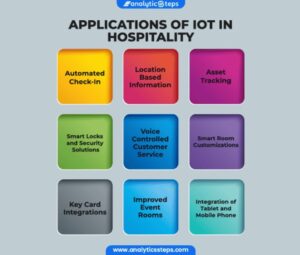George and Jane Jetson had a lot of automated gadgets in their home and George’s workplace. These tools seemed to keep things running smoothly and efficiently. Fast-forward about 60 years and the Jetson’s fantasy has become reality. The use of advance technology like artificial intelligence (AI) and augmented reality (AR) is changing the way businesses provide customer service. That’s why more and more hospitality businesses are adopting some of the same technology.
Augmented Reality
Augmented reality is technology that basically alters a person’s perception of their physical surroundings through the use of computer technology. It was first implemented in 1992 at the USAF Armstrong’s Research Lab. Essentially, AR is the use of technology to add artificial, digital qualities to real-life objects. The use of AR for entertainment purposes on smart phones and games is extremely popular. But where augmented reality is really beginning to make its mark is in the business world.
Virtual Reality
Virtual reality is a computer technology which utilizes images, sounds and physical sensations. It gives the user the feel as though they are physically present in a virtual world. It’s very useful when a hotel, restaurant, or casino wants to give the customer a taste of their future experience. There is a very slight difference between virtual reality and augmented reality. Basically, VR replaces the real-world environment with a completely virtual one. Whereas augmented reality enhances the real-world environment in real-time.
AR in Business
Both AR and VR can be considered one in the same. In fact, either route a hospitality establishment uses will be a profitable compliment to their marketing strategy. Both have been used interchangeably to give real-life experiences to customers in almost every industry. The technologies have helped businesses with staffing, supply, and safety issues for years.
For example, to speed up loading times, crews at Singapore’s airport wear AR glasses to see information about cargo containers. And housewares giant IKEA offers an AR app called IKEA Place. The app lets customers see how a piece of furniture will look and fit in a room. Also, AR helped Harley-Davidson create an iPad app that provides a virtual shopping experience. This technology gives customers the ability to try out different body types, seats, and lights for a custom bike design.
AR in the Hospitality Industry
The use of AR in the hospitality industry is becoming a more useful and important concept. AR allows hotels and other related businesses to enhance the physical environment they are selling. This technology makes information readily available to customers at all times of the day, improving their entire experience. Guests can walk around the lobby, through the halls, and visit the pool without physically being on property.
Surveys show that Millennials are the dominant hospitality consumer generation today. They are more likely than previous generations to utilize digital technology and AR devices. That is the target audience for the hospitality industry. But other generations have tinkered with AR. Case in point: During the London Olympic Games in 2012, Holiday Inn used AR to enhance the guest experience. Guests with a mobile device were able to overlay videos of their favorite athletes into a real world setting.

Other hotels have used AR to their advantage
Starwood Hotels uses “beacons” or small wireless transmitters that connect to nearby smart devices. The company used these beacons to send virtual keys to their guests to unlock their door with a smartphone. The most common uses of AR in the hospitality industry include:
- Virtual brochures-A great way to market the hospitality business. With augmented reality, the hotel or casino can allow the customer to tour the property from their smart device.
- Room access-AR can offer virtual keys on the guest’s smartphone
- Maintenance requests-The guests can point their phone cameras to things that require maintenance and send a request. They can point the camera again later to the issue and get real-time updates.
- Guest preferences-Augmented reality-based applications can help in getting details about the guest and their preferences and choices. Just through a photo, the AR setup provides details about the guest and their previous stays, room and food
- Map features-Guests can point their smartphones to a map to get a view and details of other places of interest nearby.
- Interactive rooms-Restaurants, casinos and hotels can allow the guest to get a three-dimensional display of the property. This feature allows the guest to decide of they want the poolside room or not. It gives them an idea of where table nine is located in the dining room too.
- Automatic check-in service-Guests using AR will no longer have to stop at the front desk. Their AR app will confirm the guest check-in as well as reserve a car, make dinner reservations, and more.
The beneficial features of AR for the hospitality business continue to grow as technology advances. Adopting the technology for your business now is a smart move as more of your clients will be expecting it.

The Internet of Things
What keeps us all connected and able to use AR and VI is what has been termed, The Internet of Things (IoT). IoT describes the network of physical objects, (or things), that are embedded with sensors, software, and other technologies. This is all for the purpose of connecting and exchanging data with other devices and systems over the internet. The use IoT for the hospitality industry is just beginning, but gaining tremendous traction.

As AR technology expands, the hospitality industry will be able to do more to attract and serve guests. The Millennials and the generations after them embrace AR technology. Some Baby-Boomers fear the concept of technology or “Big Brother” watching them. But that is slowly changing as more and more people are experiencing the conveniences that AR technology provides.
Steps to Bringing AR to Your Business
The technology of AR and VR is not as scary as it once was. When AR first came to light, it was thought that people will be harmed using it. It was also considered too expensive to be used in business. But today, AR technology is affordable, safe, effective and dependable. And it can be combined with other technological dimensions like IoT, big data, and virtual reality to maximize usage.
Take these three steps to get started in the world of AR technology for your business:
- Survey your needs-You may want to begin taking baby steps and only use AR for marketing. If that’s the case, determine how you want to use AR. Is it for tours? Brochures? Or maybe you want to start with virtual keys for rooms. It’s best to tackle just a few items first before diving fully into AR.
- Determine what technology service you will use-To implement AR into your business, consider examining some of the available AR apps. You can do a search or visit sites like ZealAR, Quytech, and Zappar. These will help you get an idea of costs and applications.
- Make the move-There is so much information available about AR that it’s easy to get paralysis by analysis. But don’t allow that to happen. AR technology is so versatile that once you get started, you can change paths if you need to. The key is to just make it happen.
AR is reshaping how the hospitality industry does business. The faster you get on board, the better you will be equipped to compete in your segment.

